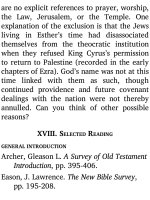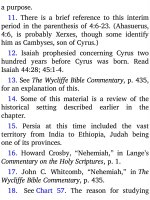Jensens survey of the old testament adam 251
Bạn đang xem bản rút gọn của tài liệu. Xem và tải ngay bản đầy đủ của tài liệu tại đây (117.46 KB, 4 trang )
for purposes of punishment?
2. In what sense is God sovereign in all of
His judgments? Can man’s repentance
change God’s pronouncement of judgment?
In answering this, see Jeremiah 18:7-10.
When is a judgment of God irreversible?
3. “I will restore to you” (2:25, KJV). Does
God still engage in the work of restoration?
Support and illustrate your answer.
4. In what ways has Israel been persecuted
by Gentiles since the days of Joel? Who has
preserved a remnant of believing Jews
through the centuries?
5. Try to think of other spiritual lessons
taught by the book of Joel.
IV.
SELECTED
GENERAL INTRODUCTION
READING
Archer, Gleason L. A Survey of Old Testament
Introduction, pp. 291-95.
Cole, R. A. “Joel.” In The New Bible
Commentary, pp. 716-17.
Freeman, Hobart E. An Introduction to the Old
Testament Prophets, pp. 145-56.
Graybill, John B. “Joel.” In The Zondervan
Pictorial Bible Dictionary.
COMMENTARIES
Deere, Derward “Joel.” In The Wycliffe Bible
Commentary.
Gaebelein, A. C. The Prophet Joel:
Schmoller, Otto. “Joel.” In Lange’s
Commentary on the Holy Scriptures.
Smith, Ward, and Smith, Bewer. Joel.
International Critical Commentary.
MICAH: WHO IS LIKE JEHOVAH?
The book of Micah is especially noted for
its predictive messages. For example, Micah
predicted the exact location of Jesus’
birthplace, Bethlehem (Mie 5:2; cf. Matt
2:5). Hobart E. Freeman observes that no
Old Testament prophet exceeds Micah in the
proportion of predictions concerning Israel’s
future and the Messiah’s advent and
Kingdom.12
I. BACKGROUND
A. THE MAN MICAH
1. Name. The name Micah means “Who is
Jehovah like?” or “Who is like unto
Jehovah?” Read the rst words of 7:18. Do
you think the prophet may have been
thinking of his own name when he penned
those words?
2. Home. Micah’s hometown was
Moreshethgath (1:1, 14), located about
twenty miles southwest of Jerusalem (see
Map Y). The name Moresheth-gath means
“possession of Gath,” which suggests that
the town was an annex of nearby Gath. The
busy highway from Egypt to Jerusalem went
through this area, so the “country boy”
Micah was not too far removed from the city
ways of his contemporary, Isaiah.
3. Time. Study Chart 80, which shows the
contemporaries (kings and prophets) of
Micah. Answer the following on the basis of
the chart:
a) Between what years did Micah minister as
a prophet?
b) What two other prophets ministered
during Micah’s time?
c) Who were Judah’s kings when Micah was
prophesying?
d) What calamity befell the Northern
Kingdom of Israel in the middle of
Micah’s ministry?
e) Read Micah 1:5-7. (Samaria was the









